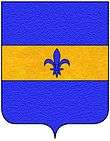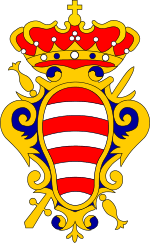Buća
| Bučić Bucchia (see Name) | |
|---|---|
 | |
| Country | Kingdom of Serbia, Serbian Empire and Republic of Ragusa |
| Founded |
|
| Dissolution | 19th century |
| Cadet branches | House of Drago-Bučić |
| Part of the series on |
| Dubrovnik nobility |
|---|
 |
| Original patriciate |
|
| Late patriciate |
|
The Buća (in Italian Bucchia) was a noble family that served the Republic of Ragusa, and one of the most important families to come out of Kotor. A cadet branch was admitted to the nobility of the Republic of Ragusa, another branch moved instead to Šibenik.
Name
The family is known in Croatian sources as Buća[1][2][3][4], but also as Bućić or Bučić.[5][6] In Latin, Italian and French sources they are known in a variet of forms, mostly Bucchia or de Bucchia, but also Buchia, Buche, Buchi, Buchie, de Bucha, de Buchia, de Bucho, de Buça, Boce o Buca. Other scarcely found versions in Croatian include Buča and Bućin.[7]
History
Origin and early history
The family name seems to derive from the medieval name Buchius or Bucchius reported both in Dalmatia and earlier in various Italian locations. The first Bučić to be in the archives is a Jakov Bučić present in Kotor in 1186.
Service in Serbia
The first known Buća was Tripe Mihov (Tripun Buća).[8] Kotoran families held high offices in the Serbian court, and the most notable was the Buča family,[8] while the most notable individual was Nikola Buća.[9] Nikola and Toma Pavlov, another notable Kotoran,[9] traded in salt.[10]
The Buća were among the wealthiest and most powerful of Kotor (Kingdom of Serbia and Serbian Empire). Founded later with the House of Drago, it gave rise to one of the most important families in the region: the House of Drago-Bučić.
Service in the Republic of Ragusa
A branch of the family moved to Sibenik in 1449, while another branch had earlier moved to Dubrovnik in the 14th century. The latter, between 1440 and 1640 counted 30 members of the Great Council, representing 1.36% of total.[11] In these two hundred years, they also got 27 senatorial positions (1.36%), five Rectors of the Republic (0.21%), five members of the Minor Council (0.23%), but were never Guards Justice.[12]
Kotoran branch became extinct in the 17th century, the Dubrovnik in the 19th century, but it seems that the branch from Šibenik still survives in Italy.
Members
 |
 |
- Nikola Buća (14th century), protovestiarios of Serbian Emperor Stephen Dušan (r. 1331-1355). It seems he was the first member of the family to be admitted to the Ragusan nobility, as requested by the Emperor.
- Jeronim Bučić (16th century) - From Kotor, was Bishop of local diocese since 1581. He edited an adaptation of The Life of St. Tryphon, adding four hymns.
- Vincenc and Dominik Bučić (16th century) - Brothers from Kotor, both Dominicans, were popular theologians, leaving several published and unpublished writings. The second was the confessor of Blessed Osanna of Cattaro and General Vicar for Dalmatia.
- Vincenc Bučić (17th century) - Bishop of Kotor from 1622 to 1656.
See also
References
- ↑ Stjepan Damjanović, ed. (1997). Prvi hrvatski slavistički kongres: zbornik radova, Volume 1. Contributor Josip Bratulić. Hrvatsko filološko društvo. p. 331. ISBN 978-953-6050-14-7.
A to su: Benešić, Buća, Basiljević. Baska, Bičići, Katena, Crević, Kalistri, Dabro, Držić, Guleniko, Goliebo, Đorđić, Mekša, Pecanja, Pucić, Soren- to, Vilpeli i Zrijević. Od lijeh u Orbinovo doba živjeli su u Dubrovniku: Benešić, Buća, Basiljević, ...
- ↑ Društvo za antički studii na SRM (1968). Živa antika, Volume 18. Društvo za antički studii na SRM, Seminar na klasična filologija, Filozofski fakultet. p. 159.
Zbog toga je također čudno što su u bibliografiji izostali, na primjer, i latinisti iz kotorskih obitelji Bizanti i Buća.
- ↑ Vinko Foretić (1980). Povijest Dubrovnika do 1808: dio. Od 1526-1808. Nakladni zavod Matice hrvatske. pp. 163–164, 211.
Nakon što je ogranak kotorske vlastelinske obitelji Buća, koji se bio nastanio u Dubrovniku, 1336. primljen u dubrovačko plemstvo.
- ↑ Savet akademija nauka SFRJ (1976). Bulletin scientifique, Volume 12, Issues 4-6. Le Conseil. p. 134.
Tripe Buća, a Dubrovnik Merchant and Minister of Finances to the Bosnian King Tvrtko I Kotromanić
- ↑ Francesco Maria Appendini, Notizie istorico-critiche sulle antichità storia e letteratura de' Ragusei, Dalle stampe di Antonio Martecchini, Ragusa 1803, p. 46
- ↑ Zdenko Zlatar, Huius... est omnis reipublicae potestas: Dubrovnik’s Patrician Houses and Their Participation in Power (1440-1640), in Dubrovnik Annals Dubrovnik, 6/2002, p. 53
- ↑ Francesco Maria Appendini, Op. Cit. p. 47
- 1 2 Bešić 1970, p. 82
- 1 2 Kostić 2001, Uvodni tekstovi, Nemanjići i Boka
- ↑ Vizantološki institut 2004, pp. 459
- ↑ Zdenko Zlatar, Op cit. p. 54.
- ↑ Zdenko Zlatar, Op cit. p. 60
Sources
- Francesco Maria Appendini, Notizie istorico-critiche sulle antichità storia e letteratura de' Ragusei, Dalle stampe di Antonio Martecchini, Ragusa 1803
- Renzo de' Vidovich, Albo d'Oro delle famiglie nobili patrizie e illustri nel Regno di Dalmazia, Cultural Scientific Foundation Rustia Traine, Trieste 2004
- Simeon Gliubich,Biographical dictionary of illustrious Dalmatian men, wien-Zadar 1836
- Giorgio Gozzi,The free and sovereign Republic of Ragusa 634-1814, Volpe Editore, Rome 1981
- Robin Harris, Storia e vita di Ragusa - Dubrovnik, la piccola Repubblica adriatica, Santi Quaranta, Treviso 2008
- Konstantin Jireček, The Legacy of Rome in the cities of Dalmatia in the Middle Ages, 3 vols., AMSD, Rome 1984-1986
- Bešić, Zarij M. (1970), Istorija Črne Gore: Od kraja XII do kraja XV vijeka. Part 2 (in Serbian), Red. za istoriju Črne Gore